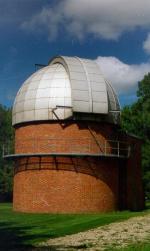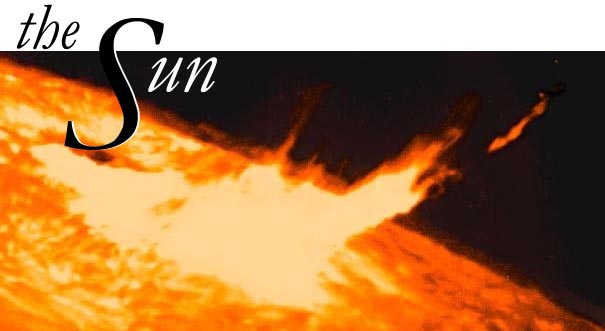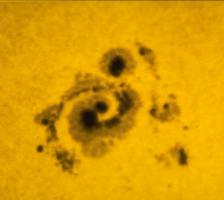| Warner and Swasey Observatory |
| Case Western Reserve University | Nassau Station |
| Visitors |
|
» Home » News » Gallery » Reference » Weather |
| Science Resources |
|
» NSRT User Interface » Software » Data Archive » Download Data |

|
 |

The Sun is the closest star to the Earth, and it provides us with the energy necessary for survival. Not only this, but the formation of the Sun is what brought about the formation of the Earth. It is not a remarkable star by anyone's standards. The Sun started out, as every star does, as nothing more than gas and dust which reached a critical density and then collapsed. The great majority of stars are in galaxies and galaxy clusters because the gas is in huge volumes which then fragment and continue to collape in a hierarchical fashion. The Sun and the system of planets orbiting it are a part of the Milky Way galaxy, a spiral galaxy.
Interesting Facts
Mass: 1.989 * 1033 grams (about 333,000 Earth masses)
Radius: 6.9599 * 1010 cm (109 Earth radii)
Luminosity: 3.826 * 1017 Giga Watts
Temperature: 6000 K on the surface, 15,000,000 K at the core
Spectral Type: G2
Composition: 75 % hydrogen, 25 % He, less than 1 % metals
Distance from Earth: 1 AU (1.5 * 108 km)
Useful Terminology
chromosphere: lies just above the photosphere, and stretches outward for about 2000 km. It is much more diffuse (gas density drops by factor of 104), but much hotter than the photosphere (4400 K - 25,000 K as you go farther out), so that it can not be seen without blocking the photosphere.
 | corona: much fainter (106 times less energetic than the photosphere), and more diffuse, the corona extends for several solar radii, but is heavily obscured by the photosphere's luminosity. Its temperature is higher than 106 K, although it is far from uniform. |
energy transport: the energy created by both nuclear reactions and gravitational collapse has to be passed out of stars somehow, and there are different processes that can take place depending on what is the most efficient.
- conduction: energy transport via particle collisions.
- convection: hot material moves up, and cooler material moves down, and forms convective cells.
- radiation: the emission and re-absorption of photons when they bump into matter.
granulation: a granular or patchwork pattern that can be seen on the surface of the Sun (top of convection zone, base of photosphere). The 700-1000 km2 patches have a characteristic lifetime of 5 to 10 minutes.
Hertzsprung-Russell diagram: a luminosity vs. temperature diagram which categorizes different types of stars together, and along which the evolution of a star can be plotted. The major parts of an H-R diagram are the main sequence, the red giants, and the white dwarfs.
hydrostatic equilibrium: a pressure gradient must exist to counteract the effect of gravity in order for a star to remain static. 
Jeans mass: a critical value of the mass of a cloud of interstellar dust and gas, above which the cloud begins to collapse. 
metals: astronomers consider any element heavier than helium a metal. This is not the correct definition in general, but it is the correct definition in astronomy.
neutrino: an either massless or extremely light particle which travels at very close to the speed of light, and does not interact with much matter. They are generated in every step of the proton-proton chain, so a lot of them are produced by Sun, and they bombard the Earth, but with little consequence. Detectors in several different countries exist which are trying to further our understanding of neutrinos, but since they have a very small cross section of interaction, this is a difficult process.
photon: the smallest unit of light. While light behaves like a wave, it comes in discrete bundles with specific amounts of energy (dependant on the wavelength).
photosphere: the observable region of the Sun. The temperature is 4400 K at the top of the photosphere, and 6500 K at its base. This is the source of optical photons.
proton-proton chain: the three step process which converts hydrogen into helium in the core of the Sun (and other stellar-sized main sequence stars). For more massive stars, the preferred process-- which accomplishes the same objective-- is the CNO (carbon-nitrogen-oxygen) cycle.
solar wind: a stream of electrons and ions that is continuously escaping from the Sun and into space.
 sunspots: cooler regions in the surface of the Sun caused by the crossing of magnetic field lines which are temporary features. The magnetic poles of the Sun switch every 11 years, so sunspots tend to moves farther and farther down during the course of the solar cycle.
sunspots: cooler regions in the surface of the Sun caused by the crossing of magnetic field lines which are temporary features. The magnetic poles of the Sun switch every 11 years, so sunspots tend to moves farther and farther down during the course of the solar cycle.
Vogt-Russell Theorem: a declaration that certain physical traits such as the mass and composition, among others, of a star uniquely determine the internal structure of that star.
all photographs: Copyright Association of Universities for Research in Astronomy Inc. (AURA), all rights reserved
Back to the NSRT Reference page
Created by Marta Lewandowska, June 1999
©1999 CWRU Astronomy Dept.
comments
Last modified June 1999
Case Western Reserve University